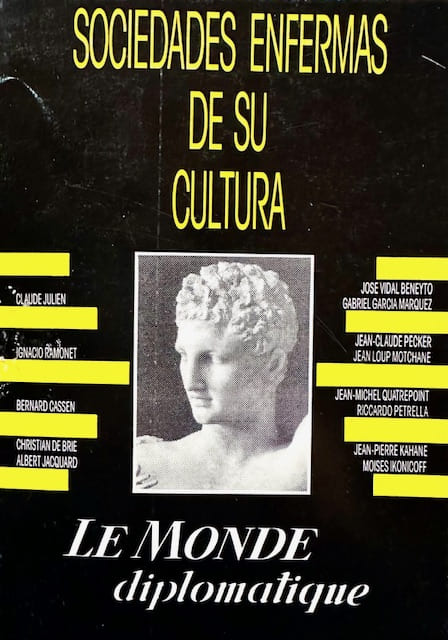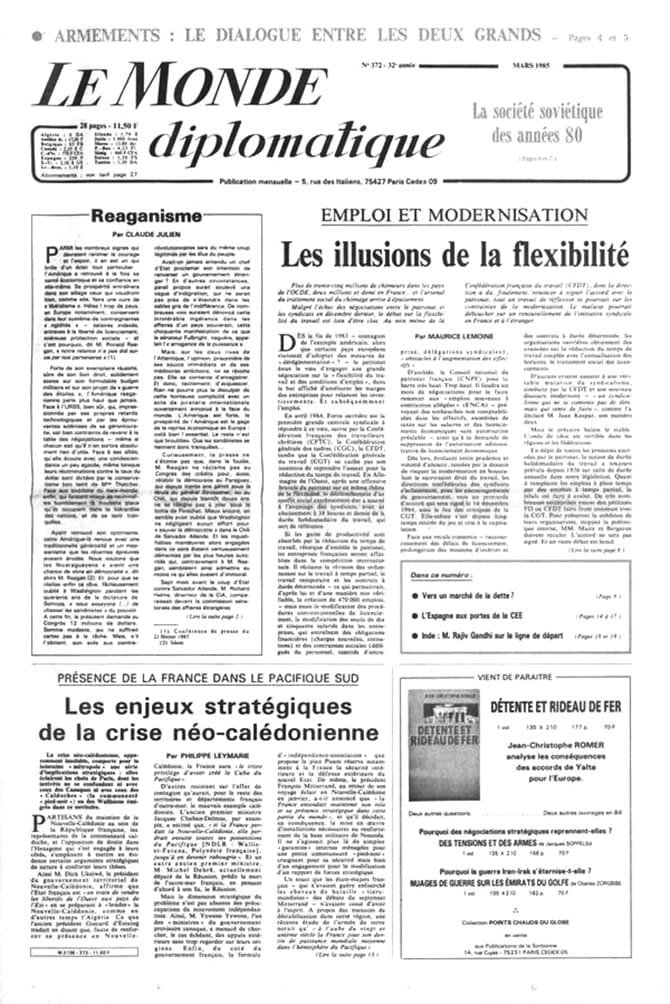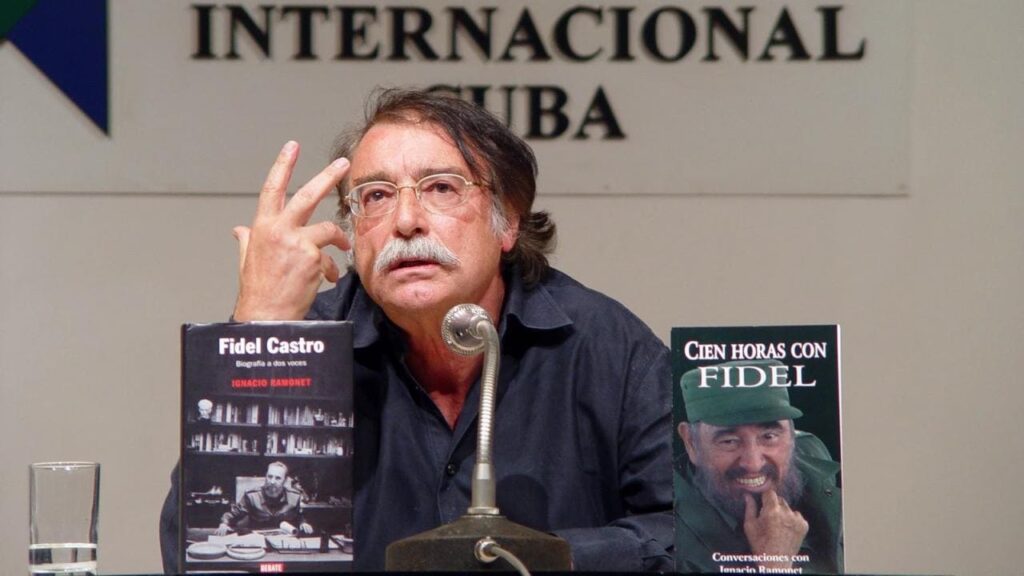hugoklico Deja un comentario Editar
Le Monde diplomatique.
SOCIEDADES ENFERMAS DE SU CULTURA
SOCIETIES SICK OF THEIR CULTURE

Since 1985 and for five intense and interesting years, Hugo A. Kliczkowski Juritz, together with Roque L. Cassini, directed Le Monde diplomatique in Spanish.
That book is the translation of the French edition, with two brief introductions from us. (1)
Le Monde diplomatique is the monthly edition of the French newspaper Le Monde. Three years later in 1988 we published the first book in the “Ways of Seeing” series.
«This translation from Spanish (the original text) to English is not professional. I used Google Translate, so there may be linguistic errors, which I ask you to overlook. I have often been asked to share my texts in English, so I decided to make an attempt. I appreciate your patience, and if you see anything that can be improved and would like to let me know, I would be grateful. Here are the lines I have written in the meantime, with all their imperfections». Hugo Kliczkowski Juritz
The cataclysm of Damocles (El cataclismo de Damocles)
By GABRIEL GARCIA MARQUEZ

One minute after the last explosion, more than half of human beings will have died, the dust and smoke of the burning continents will defeat the sunlight, and absolute darkness will once again reign in the world. A winter of orange rains and frozen hurricanes will reverse the time of the oceans and reverse the course of the rivers, whose fish will have died of thirst in the burning waters, and whose birds will not find the sky. Perpetual snow will cover the Sahara desert, the vast Amazon will disappear from the face of the planet destroyed by hail, and the era of rock and transplanted hearts will be back to its glacial childhood.
The few human beings who survive the first horror, and those who would have had the privilege of a safe refuge at three in the afternoon of the fateful Monday of the great catastrophe, will only have saved their lives to die later from the horror of their memories. The creation will be finished. In the final chaos of humidity and eternal nights, the only vestige of what life was will be cockroaches.
Dear Presidents, Dear Prime Ministers, friends. (2)
This is not a bad plagiarism of John’s delirium in his exile on Patmos (3), but rather the anticipatory vision of a cosmic disaster that can happen at this very moment: the explosion – directed or accidental – of only a minimal part of the nuclear arsenal who sleeps with one eye and watches with the other in the Santa Barbara of the great powers.
That’s how it is. Today, August 6, 1986, there are more than fifty thousand nuclear warheads in place in the world. In household terms, this means that every human being, not excluding children, is sitting in a barrel with about four tons of dynamite, the total explosion of which can eliminate all traces of life on earth twelve times over.
The annihilation power of this colossal threat, which hangs over our heads like a Damocles cataclysm, raises the theoretical possibility of disabling four more planets than those that revolve around the sun, and of influencing the balance of the solar system. No science, no art, no industry has doubled itself as many times as the nuclear industry since its origin forty-one years ago, nor has any other creation of human ingenuity ever had so much power to determine the destiny of the world.
The only consolation from these terrifying simplifications – if they are of any use to us – is to see that the preservation of human life on Earth remains even cheaper than the nuclear plague. Well, by the mere fact of existing, the tremendous apocalypse held captive in the death silos of the richest countries is ruining the possibilities of a better life for everyone.

In child care, for example, this is a truth of primary arithmetic.
In 1981, UNICEF calculated a program to solve the essential problems of the world’s poorest five hundred million children. It included basic health care, elementary education, the improvement of hygienic conditions, the supply of drinking water and food. This all seemed like a hundred billion dollar pipe dream. However, this is barely the cost of five B-13 strategic bombers, and less than seven thousand Cruise rockets in whose production the United States government must invest twenty-one billion two hundred million dollars.
In health, for example: with the cost of ten Nimitz nuclear aircraft carriers, of the fifteen that the United States will manufacture before the year 2000, a preventive program could be carried out that would protect more than one billion people in those same fourteen years. against malaria, and will prevent the death – in Africa alone – of more than fourteen million children.
In food, for example: last year there were, according to FAO calculations, some five hundred and seventy-five million hungry people in the world.
Its essential caloric average would have cost less than one hundred and forty-nine MX rockets, of the two hundred and twenty-three that will be deployed in Western Europe. Twenty-seven of them could buy the agricultural equipment necessary for poor countries to achieve food sufficiency in the next four years. Furthermore, this program would not cost even one-ninth of the 1982 Soviet military budget.
In education, for example: with only two Trident atomic submarines, of the twenty-five that the current United States government plans to manufacture, or with a similar number of the «Typhoon» submarines that the Soviet Union is building, it could finally be attempted the fantasy of global literacy. On the other hand, the construction of the schools and the qualification of the teachers that the third world will need to meet the additional demands of education in the ten years to come, could be paid for with the cost of two hundred and forty-five Trident II rockets, and there would still be four hundred and nineteen rockets left over for the same increase in education in the following fifteen years.

It can be said, finally, that the cancellation of the external debt of the entire third world, and its economic recovery for ten years, would cost little more than a sixth of the world’s military expenditures in that same time. However, in the face of this enormous economic waste, the human waste is even more disturbing and painful: the war industry keeps in captivity the largest contingent of wise men ever assembled for any enterprise in the history of humanity. Our people, whose natural place is not there but here, at this table, and whose liberation is essential to help us create, in the field of education and justice, the only thing that can save us from barbarism: a culture of peace.
Despite these dramatic certainties, the arms race does not allow itself a moment’s respite. Now, while we were having lunch, a new nuclear warhead was built. Tomorrow, when we wake up, there will be nine more in the death rows of the hemisphere of the rich. The cost of just one of them would be enough – even if only for one autumn Sunday – to perfume the Niagara Falls with sandalwood.
A great novelist of our time once wondered if the earth is not the hell of other planets. Perhaps it is much less: a village without memory, left by the hand of its gods in the last suburb of the great universal homeland. But the growing suspicion that it is the only place in the solar system where the prodigious adventure of life has taken place, mercilessly drags us to a disheartened conclusion: the arms race is going in the opposite direction of intelligence.
And not only of human intelligence, but of the intelligence of nature itself, whose purpose even escapes the clairvoyance of poetry. Since the appearance of visible life on Earth, three hundred and eighty million years had to pass for a butterfly to learn to fly, another one hundred and eighty million years for making a rose with no other commitment than to be beautiful, and four geological eras for Human beings – unlike great-grandfather Pithecanthropus – were capable of singing better than birds and dying of love.
It is not at all honorable for human talent, in the golden age of science, to have conceived a way that such a wasteful and colossal multi-millennial process can return to the nothingness from which it came by the simple art of pressing a button.

To try to prevent that from happening we are here, adding our voices to the countless others crying out for a world without weapons and peace with justice. But even if it happens, it won’t be entirely useless for us to be here. Millions of millennia from now after the explosion, a triumphant salamander that has once again traversed the entire scale of species will perhaps be crowned the most beautiful woman of the new creation. It depends on us, men and women of science, men and women of arts and letters, men and women of intelligence and peace, it depends on all of us that the guests at this chimerical coronation do not go to their party with our same terrors. today. With all modesty, but also with all the determination of the spirit, I propose that we make now and here the commitment to conceive and manufacture an ark of memory, capable of surviving the atomic flood.
A bottle of sidereal castaways thrown into the oceans of time, so that the new humanity of that time knows from us what the cockroaches will not tell it: that life existed here, that suffering prevailed and injustice predominated, but that We also knew love and were even able to imagine happiness. And let him know and let it be known for all time who were the culprits of our disaster and how deaf they became to our cries for peace so that this would be the best of all possible lives, and with what such barbaric inventions and for what petty interests They erased her from the universe.
Notes
1
The French edition was made up of:
Founder Hubert Beuve Mery
Director Claude Julien
Editor-in-chief Micheline Paunet
Editorial Ignacio Ramonet, Alaib Greah, Bernard Cassen, Christian De Brie
Editorial Secretary Solange Brand
Graphic Conception Magnus Harling, Dominique Mesnier
Editorial 7 rue des Italiens, (75427) Paris.
The Latin American edition was made up of:
Director Hugo A. Kliczkowski Juritz
Responsible Editor Roque L. Cassini
General Secretary Ana Esteras
Editorial Coordination Silvia L. Wladimirski
Translation Diana Navarro
Cover Daniela Pugliese
Editorial 25 de Mayo 596, 5th floor (1002) Buenos Aires
2
Palabras pronunciadas en la sesión inaugural de la Conferencia por la paz y el desame, realizada en Ixtapa (México) el 6 y 7 de agosto de 1986 y en la que participaron los presidentes Raúl Alfonsán (Argentina) y Miguel de la Madrid (México); los primeros ministros Andreás Papandréou (Grecia), Rajiv Gandhi (India) y Ingvar Carisson (Suecia) y el ex presidente de Tanzania, M. Julius Nyarere (N. de la R.).
3
Isla griega donde el evangelista Juan escribió el Apocalipsis.
—————————————
Nuestro Blog ha obtenido más de 1.300.000 lecturas: http://onlybook.es/blog/nuestro-blog-ha-superado-el-millon-de-lecturas/

Arq. Hugo Alberto Kliczkowski Juritz
Onlybook.es/blog
Hugoklico.blogspot.com

Salvemos al Parador Ariston de su ruina
http://onlybook.es/blog/el-parador-ariston-
Post navigation
Entrada anteriorGB. Carlo Scarpa 1. The architecture of history. (mbgb)